Plantain Herb Benefits, Recipes & How To Identify
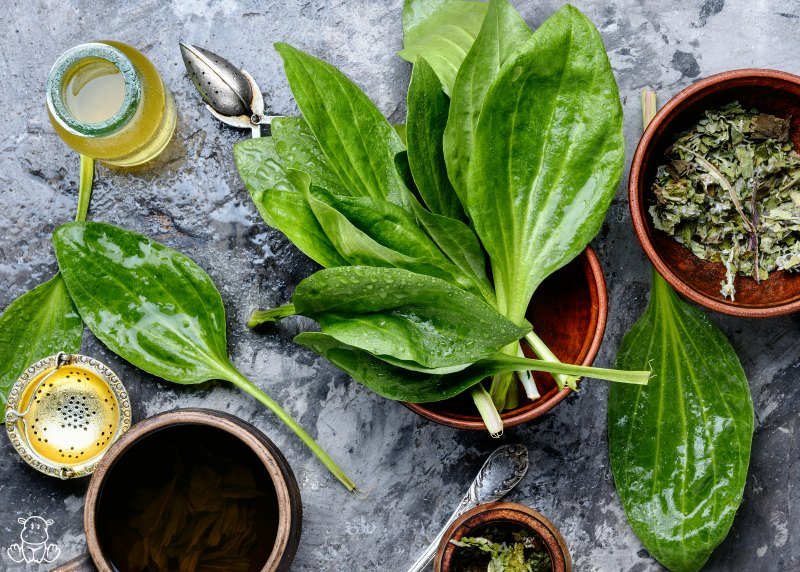
False unicorn root, Balsam of Tolu, Mugwort . . . when it comes to herbs, there are so many intriguing ones on my bucket list to try. For all their exotic sounding names, though, they can’t compete with the humble plantain herb. I stand by what I wrote in this plantain salve recipe tutorial, which is that if you only know one plant in the wild, it should really be plantain. (I’m talking about the “weed,” not the banana, of course!)
Why is this herb so useful, you ask? For the two most common types you’ll find in the United States – broadleaf plantain/greater plantain (Plantago major) and ribwort plantain (Plantago lanceolata) – here are five reasons:
- Availability – Like dandelion, it grows just about everywhere, so you can almost always find it when you need it (Or if it’s the wrong season, you can use some you’ve collected and dried)
- Identification – It’s easy to recognize (tips below)
- Versatility – It can be made into a tea, poultice, infused oil, tincture, salve, salad and more (Recipes below)
- Safety – Plantain is a Safety Class 1A herb according to the Botanical Safety Handbook, which is the safest rating possible
- Cost – It’s usually free, my favorite price!
Chaucer called it the “herb sovereine.” Shakespeare referred to it often in plays – three, to be exact.
It was known among Native American peoples as “white man’s foot” or “footprint.” Mostly that’s because European settlers brought it to North America for use as a therapeutic or medicinal herb, and as a result it seemed to follow wherever they went.
Plantain Leaf Benefits & Uses
Plantain leaves contain several bioactive compounds which contribute to its therapeutic properties. They also naturally contain mucilage, which is a gel-like consistency that moistens and cools irritations. Mucilage also helps coat the area, thus supporting mucous membrane integrity.
Plantain also contains several bioactive compounds. It’s anti-inflammatory due to the presence of iridoids (particularly aucubin) which studies have also found to have antibacterial properties. (1) It also contains aucubigenin and aglycone – which have documented antimicrobial activity – and allantoin, which supports tissue regeneration and skin healing. (2, 3)”
According to herbalist David Hoffman, author of Medical Herbalism, plantain is also an astringent (aka an herbal drawing agent) and a diuretic. Sometimes called the “green band-aid” because it’s so helpful in many first aid situations, the leaf can be used externally for soothing:
- Insect bites/mosquito bites
- Bee stings
- Scrapes
- Sunburn
- Poison ivy
- Acne
- Bruises
- Drawing out splinters
The most common preparations for external use are a poultice, tincture, salve, or vinegar infusion. (Recipes below.)
Internally, in the form of a tea or tincture, it can be used to soothe the digestive tract and urinary tract. According to herbalist David Hoffman, plantain also “acts as a gentle expectorant while soothing inflamed and sore membranes, making it ideal for coughs and mild bronchitis.” (4)
Other parts of the plantain plant are also sometimes used in remedies, such as:
- Plantain seed – In traditional Persian medicine, the seeds are considered to have a mild laxative effect. They’re also high in (5)
- Aerial parts – In traditional folk medicine, the aerial parts (flowers and stems, not just the leaves) have been used as a diuretic (6)
How To Identify Plantain Herb
If you’re new to identifying herbs, plantain is a great one to start with. According to Steve Brill and Evelyn Dean, authors of Identifying & Harvesting Edible and Medicinal Plants (And Not So Wild Places):
Several species thrive throughout North America, without poisonous look-alikes.”
Plantain grows in open, sunny fields, cracks in sidewalks, yards and gardens. The two most common types you’ll find in the U.S. are greater plantain (Plantago major) and ribwort plantain (Plantago lanceolata). Below is a video I filmed with my daughter several years ago when we were gathering plantain. Below the video you’ll also find a list of what to look for when identifying both types:
BROADLEAF PLANTAIN (PLANTAGO MAJOR)
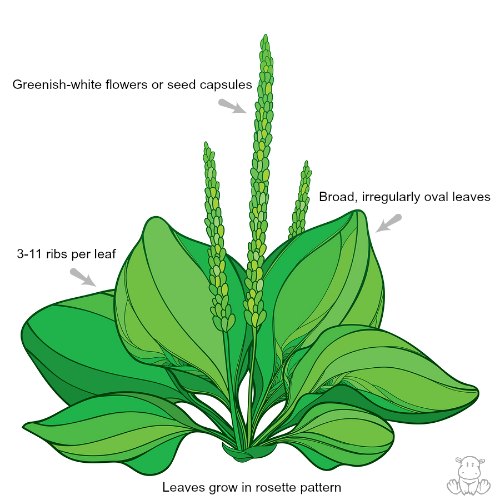 Also known as common or greater plantain, this herb:
Also known as common or greater plantain, this herb:- Has broad, irregularly rounded oval leaves
- Grows in rosettes (a rose shaped pattern) very close to the ground
- Has 3-11 ribs that run the length of each leaf
- Each leaf has its own long, fibrous stalk
- Can have tiny, greenish-white flowers or seed capsules in the center
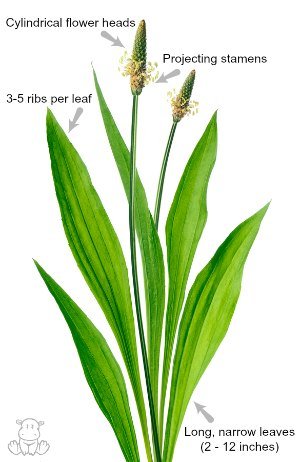
NARROW LEAF PLANTAIN (PLANTAGO LANCEOLATA)
Also known as ribwort plantain, this herb has:
- Long, narrow leaves that grow from 2-12 inches in length
- 3-5 ribs that run the length of each leaf
- Very long flower stalks with cylindrical flower heads and golden or white projecting stamens
Here are some additional pictures of plantain to help you on your search.
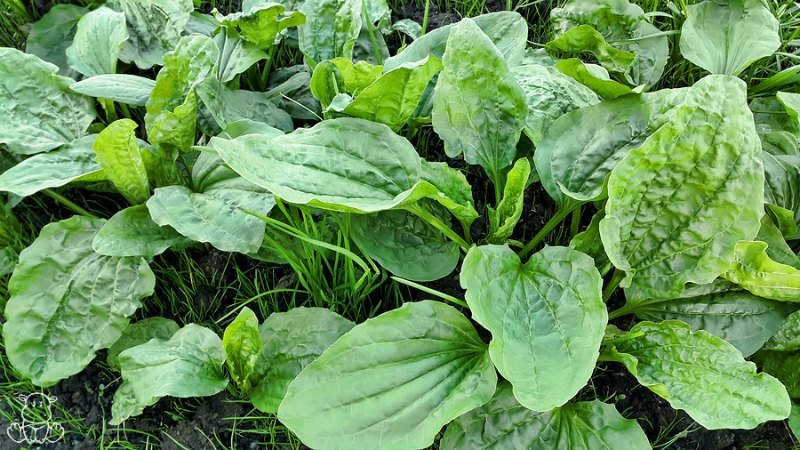
Young broadleaf plantain plant. No seed capsules in the center have formed yet.
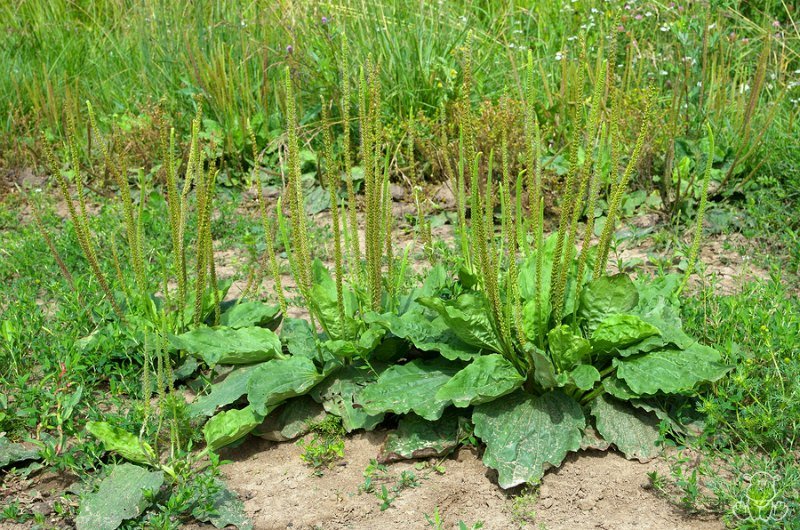
Mature broadleaf plantain herb
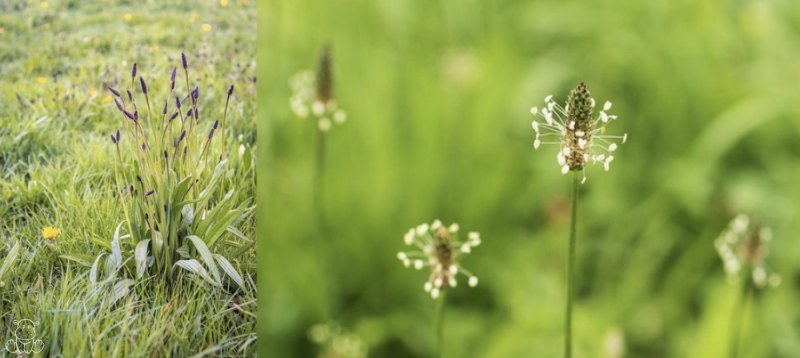
(Left) Narrowleaf plantain with cone-shaped flowers, no stamens yet. (Right) Up-close look at stamens
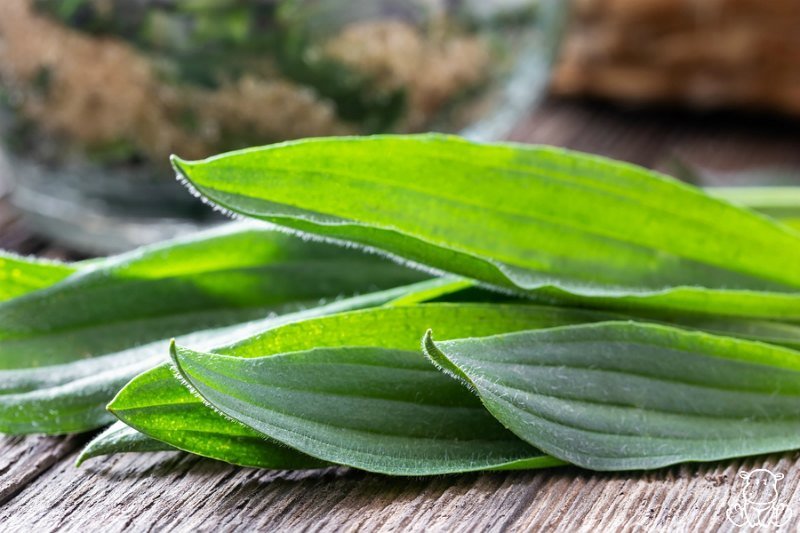
Up close look at fresh ribwort (narrowleaf plantain) leaves
How To Make A Plantain Herb Poultice
The simplest way to support wound healing with plantain is to pick a leaf, chew it, and place it directly on the affected area.
If chewing on a leaf is not your style (and I totally get that), here’s another way to make a poultice:
Place fresh plantain leaves in a food processor with a small amount of water. You don’t want it to be runny, so just add enough liquid to make a thick slurry. Place the the slurry in the middle of a piece of cheesecloth and fold it or tie it to seal the plantain inside. Place the poultice on the area for up to two hours, securing with medical tape if desired so that it stays in place. Refresh with a new poultice if desired.
Plantain Tea Recipe
Ingredients:
- 2-3 tablespoons fresh plantain leaves (rinsed) or 2 teaspoons dried plantain leaves
- 1 cup boiling water
Directions: Pour boiling water over the leaves and allow them to infuse for 10 minutes. Next, strain out the leaves and sweeten with honey, maple syrup, or another sweetener if desired.
How To Make Plantain Salve
Plantain leaves can be used alone or combined with other herbs such as calendula or comfrey to make a soothing skin balm. Here’s my plantain salve recipe.
Plantain Tincture Recipe
This tincture is particularly helpful for poison ivy that’s in the weeping stage. It also makes a good astringent for acne.
Ingredients:
- 1/2 cup freshly chopped or ground plantain leaves or 1/4 – 1/3 cup dried plantain leaves
- 1 cup 151 proof to 160 proof alcohol (That’s 75.5% to 80% alcohol by volume)*
Place the plantain in a clean 16 ounce mason jar. Pour the vodka over the leaves. After the leaves have settled that should be at least 1/2 inch of alcohol covering the top of the leaves – if that’s not the case, add more. Place the lid on the jar and shake well, then place the jar in a cool, dark place for 4-6 weeks. When the tincture is ready, strain out the plantain and label it.
* If you’re working with dried plantain, you can use 40% to 50% alcohol by volume (80- to 90-proof vodka)(7)
Usage: According to medical herbalist Richard Whelan, “Plantain is extremely safe to use in high or frequent doses if necessary and may be taken by the young or old, whilst pregnant or during breastfeeding with confidence.” (8)
Plantain Salad & Stew (Yes, really!)
Plantain leaves can also be added to salads for a nutritional boost. Use young, tender leaves rather than bigger leaves, which can be fibrous and hard to chew. Older leaves are best used in stews or to make tea.
How safe is plantain?
According to the Botanical Safety Handbook: 2nd Edition, common plantain (Plantago major), English plantain (Plantago lanceolata) and hoary plantain (Plantago media) are all Safety Class 1A herbs, which is the safest rating possible. Herbs in this category are described as:
“Herbs that can be safely consumed when used appropriately.
- History of safe traditional use
- No case reports of significant adverse events with high probability of causality
- No significant adverse events in clinical trials
- No identified concerns for use during pregnancy or lactation
- No innately toxic constituents
- Toxicity associated with excessive use is not a basis for exclusion from this class
- Minor or self-limiting side effects are not bases for exclusion from this class”
Always check with your doctor before adding herbs to your diet, and listen to your intuition to help you make the best choice for yourself.”
Sources:
1. Villasenor, Irene (2007) Bioactivities of Iridoids. Retrieved from http://www.eurekaselect.com/66121/article/bioactivities-iridoids
2. Drugs.com: Plantago. Retrieved from https://www.drugs.com/npp/plantain.html#ref2
3. Winston, David (2003) Herbal Therapeutics: Specific Indications for Herbs & Herbal Formulas (8th Edition)
4. Hoffman, David (2003) Medical Herbalism: The Science Principles and Practices of Herbal Medicine
5. Najafian, Younes et. al. (2018) Retrieved from Plantago major in Traditional Persian Medicine and modern phytotherapy: a narrative review. https://www.ncbi.nlm.nih.gov/pmc/articles/PMC5878035/
6. Tosun F. Chemical constitution and medical usage of Plantago L. species [in Turkish]. Hacettepe Universitesi Eczacilik Fakultesi Dergisi. 1995;15(1):23-32.
7. Jim McDonald: Herbalist. Herbal Preparations. Retrieved from https://www.herbcraft.org/preparations.html
8. https://www.rjwhelan.co.nz/herbs%20A-Z/plantain.html
2. Drugs.com: Plantago. Retrieved from https://www.drugs.com/npp/plantain.html#ref2
3. Winston, David (2003) Herbal Therapeutics: Specific Indications for Herbs & Herbal Formulas (8th Edition)
4. Hoffman, David (2003) Medical Herbalism: The Science Principles and Practices of Herbal Medicine
5. Najafian, Younes et. al. (2018) Retrieved from Plantago major in Traditional Persian Medicine and modern phytotherapy: a narrative review. https://www.ncbi.nlm.nih.gov/pmc/articles/PMC5878035/
6. Tosun F. Chemical constitution and medical usage of Plantago L. species [in Turkish]. Hacettepe Universitesi Eczacilik Fakultesi Dergisi. 1995;15(1):23-32.
7. Jim McDonald: Herbalist. Herbal Preparations. Retrieved from https://www.herbcraft.org/preparations.html
8. https://www.rjwhelan.co.nz/herbs%20A-Z/plantain.html
No comments:
Post a Comment